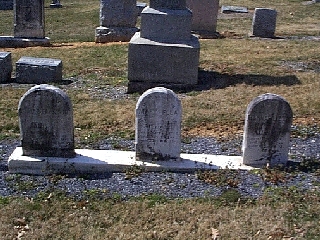 The
Silken Tent
The
Silken Tent
My Letter
to the World -- April, 1999
 The
Silken Tent
The
Silken Tent
My Letter
to the World -- April, 1999
I took an "Intuitrip" yesterday
-- a suggestion from Kay Leigh Hagan's Prayers to the Moon. The
rules were: Go someplace you've never been, taking provisions and your
journal, but no expectations. Allow your intuition to lead the way and
notice when serendipity changes your path. (My mother would have called
this "gallivanting" -- riding around with no real purpose when you could
have been practicing your violin or cleaning the house!)
It's hard for me to go without any expectations to a place I can visit and return from in a few hours. I've lived in this area all my life, and I pretty much know what to expect.
I decided that I wanted to stand in a place I've only ever seen at 65 mph from the turnpike (I-76, a restricted access toll road that slices east-west across the southern third of Pennsylvania from Philadelphia to the Ohio gateway).
Just before Exit 22 (the one for Reading -- I live not far from Exit 19), the road passes under a bridge marked "Sixth Street." To the south is a little town which can surprise someone who has just driven through forty miles of rolling farm acreage and state woodland preserve. To the north is a structure that looks like a red barn with a white silo attached, but I know it's a house.
I bought a street map of Lancaster
County and determined that I would have to go all the way to the Reading
exit and double back. I stopped for a snack at The Crossroads food and
fuel plaza -- the place where Rtes. 222 and 322 intersect, or: 2
322
2
(Not sure how THAT will work in
HTML!!)
Rte. 322 takes one into Ephrata, a town founded by Brethren and Mennonite settlers and which is the site of the famous (around here) Ephrata Cloister, a now-defunct 18th century community of religious celibates of the Seventh-Day Baptists. (As irreverent students at a nearby college, my friends and I called this place E-farta, and referred to its neighbor, Lititz, birthplace of the pretzel, as Le-Tits. What did we know?! May God, and the citizens of these two charming towns, forgive us.) Turning right just past The Crossroads takes one along Ridge Road.
I think there's a Ridge Road in every wooded suburb of every town in Pennsylvania. This is rolling country, but a lot of these ridges have been created by the earth that was pushed aside to make room for the interstates and their vast honeycomb of cloverleafs and overpasses. The one I found myself on winds past developments of "tract mansions" -- big brick-front places with fan-shaped windows and look-alike playhouses out back -- separated by little pockets of frame story-and-a-half houses and mobile homes up on blocks.
At Church Road (another common place
name that every village around here has) I turned west again, this time
into Cocalico Township. On the outskirts of Denver, which is what I had
determined to be the town visible from the turnpike, I stopped to photograph
the first shop sign I came to. 
The proprietor was out back waxing
a board, but absolutely nothing else was going on there -- I would suspect
a shop like that doesn't have a lot of traffic on a school session Wednesday
morning.
In fact, all the streets of Denver were deserted. About two miles from Fictitious Sports I encountered Sixth Street. I turned right, drove over the bridge I had heretofore only passed under, and found myself in front of the cul-de-sac which held the red barn house.
The house sits on a precipice. A formidable looking chain link fence runs along the back of the property, which drops off sharply to the turnpike below. I don't have a picture of it -- there was a car in the driveway, and the last time I photographed someone's house (the place my mother lived as a boarder before she was married) the current resident came out and yelled at me. What I noticed, though, was how small it was.
Without the silo it's an ordinary red aluminum two-story, about 1200 square feet, maybe three bedrooms (two of them tiny) and a bath and a half. With the silo it's a funny looking 1200 sf. tract house -- the silo has no windows, and it's hard to tell if it's just decorative, or a storage area, or maybe an imaginative staircase. The house is parked on the cul-de-sac between a block apartment house and a rather run-down sandstone place that is probably 200 years old.
The experience was not unlike that explored in Thomas Wolfe's short story "The Far and the Near," in which a train conductor visits a woman he's seen for years working about her property who waves as he passes on his route. When he finally has an opportunity to visit her, the moment becomes awkward, as, absent their accustomed roles and their habitual relationship, he finds they cannot relate to each other.
Having nothing else to do, I drove back to Church Road. Now I faced the task of getting home. If I could have descended off the precipice and picked up the turnpike, the trip would have taken less than half an hour. But I was situated between two interchanges -- about fifteen miles farther from my home one way, or ten miles closer another, with not a clear idea of where I would find the toll plaza.
I knew if I just kept driving west on Church Road, about parallel to the turnpike, I'd eventually run right into the outskirts of the Harrisburg area -- how far out was a guess. So that's what I did This meant that I spent a glorious spring day driving through some of the richest farm land in the state, past big cattle and dairy operations that are still traditional family farms, and native limestone places with a barn out back that are now a gentleman's "farmette," a place to keep a daughter's show horse, as well as dilapidated wooden houses with a few goats and some chickens penned in the side yard..
The name of the road kept changing -- Church Road became Steinmetz Road and then turned into Mt. Airy Road and finally Clay Road, where I ran into Rte. 322 again, here called the 28th Division Highway. On familiar ground now (I could see the first of the Hershey attractions in the distance), the "intuitive" part of the trip was over and I was just moving through traffic on my way home.
The trip directions suggested bringing back a souvenir. The picture of the Fictitious Sports place was not enough, I decided, because it was neither special to the region nor emblematic of me. But on Stenmentz Road I took a picture of something that was.
 No
trip that I take, whether it be to a neighboring state or a country in
Europe, is complete without a visit to a cemetery. On Steinmetz Road, across
from what was surely once Steinmetz Church (now "The Old Country Church,
services Sunday and Wednesday Evenings") was Steinmetz Cemetery, maybe
a half acre of graves dating from the 18th and 19th centuries up through
the middle of the 20th. The space is well kept, and a veterans' organization
obviously takes care of placing appropriate markers (both for Civil War
and WWI soldiers) but I didn't see any personal wreaths, such as for Christmas
or a parent's birthday.
No
trip that I take, whether it be to a neighboring state or a country in
Europe, is complete without a visit to a cemetery. On Steinmetz Road, across
from what was surely once Steinmetz Church (now "The Old Country Church,
services Sunday and Wednesday Evenings") was Steinmetz Cemetery, maybe
a half acre of graves dating from the 18th and 19th centuries up through
the middle of the 20th. The space is well kept, and a veterans' organization
obviously takes care of placing appropriate markers (both for Civil War
and WWI soldiers) but I didn't see any personal wreaths, such as for Christmas
or a parent's birthday.
The grave site pictured remembers the sons and daughters of John and Nancy Albright: Adam, aged six; Franklin, aged eighteen months; Mary Ella, two and a half; and Hannah Lizzie, almost eleven, all of whom succumbed, probably to some kind of flu, in the first three weeks of November, 1883. (There are three stones because Adam and Franklin share the leftmost one.)
Not unlike my beloved Whitmoyer plot in Wernersville, it stands as testimony to what must have been the darkest of winters for a country husband and wife. Gone But Not Forgotten, they'd had engraved in the base. Stone remembers, I know, but I wondered how long it had been since any living person connected to these lost children had stood in a soft spring wind and spoken their names.
I spoke their names yesterday. And I speak them again today, along with the names of some who, for reasons beyond death and time, have been absent too long from my prayers.
My trip, it seems, was worth the
effort.